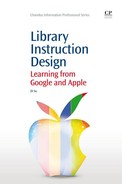Appendix 4
Digital information retrieval: sources & techniques
(Sample—The Apple Style: a creditbearing library course syllabus)
COURSE DESCRIPTION
This course introduces major reference databases in academic libraries as well as selected reliable reference and information sources on the Internet. Contents include an overview of online reference databases and networks; standard search methods using access points; formulating search queries; search strategies and techniques; introduction to reliable ready-reference sources on the Internet; open-access academic journals; criteria for selecting and evaluating reference databases and Internet sources; and online bibliographic tools.
METHOD OF INSTRUCTION
The course consists of lectures, readings, class discussions, online demonstrations, hands-on exercises, assignments, a midterm exam, and a final project.
COURSE OBJECTIVES
By the completion of this course the student will be able to:
■ demonstrate familiarity with major reference databases in academic libraries
■ choose relevant reference databases and formulate appropriate search statements
■ conduct a reference database search by using controlled vocabulary, access points, Boolean Logic Operators, nesting, truncation, and other advanced search techniques
■ select reliable and relevant Internet sources for his / her research topic by using evaluation criteria
■ find, analyze, and utilize digital information effectively and critically
■ demonstrate familiarity with open-access academic journals
TEXTBOOK
Katz, William A. (2001). Introduction to Reference Work, Volume II: Reference Services and Reference Processes, 8th Edition. New York, NY: McGraw-Hill. ISBN: 978-0072441437.
READING LIST
Bush, Vannevar (1945). ‘As We May Think,’ The Atlantic July: 101–8. <http://www.theatlantic.com/unbound/flashbks/computer/bushf.htm > .
Drobnicki, John A., and Richard Asaro (2001). ‘Historical fabrications on the Internet: recognition, evaluation, and use in bibliographic instruction.’ Reference Librarian 35/74: 121–64.
Piper, Paul S. (2000). ‘Better Read That Again: Web Hoaxes and Misinformation.’ Searcher 8: 40–9.
Straw, Joseph E. (2001). ‘From Magicians to Teachers: The Development of Electronic Reference in Libraries: 1930–2000.’ The Reference Librarian 35/74: 1–12.
Su, Di (1999). ‘Electronic Stacks: Using Web Sources in Reference Service.’ The Reference Librarian 31/65: 161–76.
Su, Di (2010). ‘Standardization of Keyword Search Mode.’ Journal of Electronic Resources Librarianship 22/1: 28–39.
Tyburski, Genie (2000). ‘Honest Mistakes, Deceptive Facts: Judging Information on the World Wide Web.’ Legal Assistant Today March/April: 54–60.
Watts, Margit M. ed. (2008). Information Literacy: One Key to Education. San Francisco, CA: Jossey-Bass.
PREREQUISITES
Computer literacy: Microsoft Word, Microsoft PowerPoint, and common Internet applications.
REQUIREMENTS & POLICIES
■ Class attendance and participation is expected.
■ Assignments and final project will be completed out of class.
■ Midterm exam will be taken in the classroom.
■ Bibliographies must adhere to the specified style, e.g. APA.
■ Plagiarism is prohibited. Violation of academic integrity will result in failing the course.
GRADING
The final grade will be determined by the level of participation in class discussions, grades on assignments, quality of written papers, midterm exam, and final project.
SCHEDULE AND TOPICS
[Week 1] Introduction to electronic reference and information resources
[Week 2] Interpretation of information sources
[Week 3] Online public access catalog (OPAC)
[Week 4] Bibliographic utility networks and consortiums
[Week 5] Research databases: EBSCO, JSTOR, Lexis-Nexis, ProQuest, Gale, and more
[Week 6] Database search strategies and techniques
[Week 7] The Internet and World Wide Web
[Week 9] Web source selection and evaluation
[Week 10] Web source vs. print: advantages and
[Week 11] Resources for Library and Information Science on the Internet
[Week 12] Selected reliable ready-reference sources on the Internet
[Week 13] Open-access academic journals
